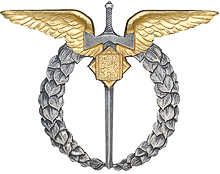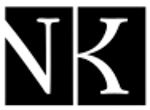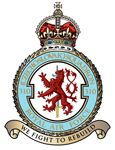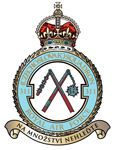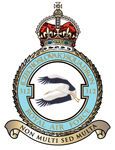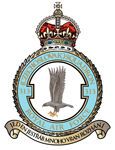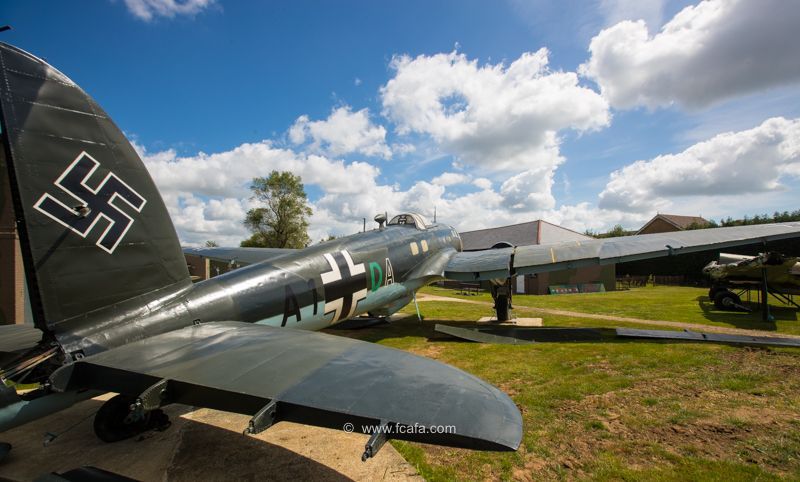
The Kent Battle of Britain Museum at Hawkinge, Kent, UK, houses the world’s largest collection of artifacts and memorabilia from that 16 week battle.
The Kent Battle of Britain Museum v britském Kentu uchovává největší světovou sbírku artefaktů a památek připomínajících 16 týdnů bitvy o Británii.

S/Ldr Alexander Hess
During the Autumn of 2019, the Museum acquired a CASA 2.111.B. from the Imperial War Museum, Duxford. On inspection of the airframe, whilst still at Duxford, the team of Volunteers from the Kent Battle of Britain Museum Trust were excited to discover construction plates that showed she was originally constructed as a Heinkel He 111H-16 (we believe in 1942), exported to Spain in late 1943 and converted to a CASA 2.111.B in February 1952, when her Jumo 211 engines were exchanged to Rolls Royce Merlins.
Na podzim 2019 muzeum získalo z Imperial War Museum v Duxfordu stroj CASA 2.111.B. Při prohlídce rámu letadla, tou dobou stále ještě v Duxfordu, s překvapením objevil tým dobrovolníků z The Kent Battle of Britain Museum Trust konstrukční štítky, které odhalily, že původně byl tento stroj postaven jako Heinkel He-111H-16 (přepokládáme, že v roce 1942). Koncem roku 1943 byl převezen do Španělska a v únoru 1952 přestavěn na CASA 2.111.B, kdy došlo k výměně motorů Jumo 211 za motory Rolls Royce Merlin.
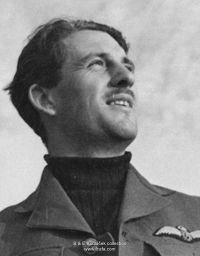
F/Lt Jerrard Jefferies
Prior to being at Duxford it had been a gate-guardian in Spain and had been used in the 1968 film ‘The Battle of Britain’ in which it had flown 13.5 hours. During that Winter to Spring 2020, the Museum restored to a Heinkel He 111H-2 bomber, in the livery of A1+DA from Stab Kampfgeschwader 53 which was shot down on 15 September 1940 – now commemorated as Battle of Britain Day – over East London. In the UK, there are only two examples of a Heinkel He III and A1+DA being the only bomber variant. More information about its past was revealed when the paintwork was removed from the leading edge of the port wing stub, when German style battle damage repair to a bullet hole was discovered, confirming that it had flown with the Luftwaffe during WW2 and had seen combat.
Dříve, než se dostal do Duxfordu, byl umístěn u brány do kasáren ve Španělsku. V roce 1968 se objevil ve filmu „The Battle of Britain“, při jehož natáčení nalétal 13,5 hodiny. V průběhu zimy 2019/2020 a následujícího jara ho zrestaurovali do podoby bombardéru Heinkel He-111H-2 v barvách stroje A1-DA od Stab Kampfgeschwader 53, sestřeleného 15. září 1940. Tento den je dnes připomínán jako Den bitvy o Británii nad východním Londýnem. V Británii se dochovaly dva kusy stroje Heinkel He-111 a A1+DA, je tedy jediným zachovaným kusem výše uvedené varianty. Další údaje o jeho minulosti se objevily po odstranění nátěru náběžné hrany pravého centroplánu, kde byla objevena oprava průstřelu kulkou provedená typicky německým způsobem. To potvrzuje, že tento stroj používala za druhé světové války Luftwaffe a prošel bojovým střetnutím.

Sgt Josef Vopálecký
On 15 September, the 1st and 2nd Gruppen of Kampfgeschwader 53, comprising of twenty-four Heinkel He 111’s, had taken off from Lille-Nord in France and met twenty-eight Heinkel He 111’s of Kampfgeschwader 26, forty-three Dornier Do 17’s of Kampfgeschwader 2 and nineteen Dornier Do 17’s of Kampfgeschwader 3 north of Boulogne at 14:05 hours. Accompanied by approximately four hundred and fifty fighters they crossed the coast at Dungeness heading towards their targets in London. Arriving over East London at 14:45 hours, Kampfgeschwader 53, in the centre column, were hit by forty-one RAF fighters. It was during the ensuing dogfight that A1+DA was shot down.
15. září 1940 odstartovalo z francouzského letiště Lille-Nord 22 stojů Heinkel 111 od 1. a 2. skupiny 53. bombardovací eskadry. Severně od Bolougne se ve 14:05 spojily s osmadvaceti stroji Heinkel He-111 od 26. bombardovací eskadry, třiačtyřiceti stroji Dornier Do-17 do 3. bombardovací eskadry a devatenácti Dorniery Do-17 od 3. bombardovací eskadry. Doprovázelo je přibližně čtyřistapadesát stíhačů. Společně překročily pobřeží v Dungeness a směřovaly ke svým cílům v Londýně. Nad město se dostaly ve 14:45. Bombardovací eskadra 53 v centrální části skupiny byla napadena jedenačtyřiceti stíhači RAF. V průběhu tohoto střetnutí byl A1+DA sestřelen.

Heinkel He 111H-2 A1+DA of of Kampfgeschwader 53, taken shortly before it was shot down on 15 September 1940.
Heinkel He 111H-2 A1+Da od Kampfgeschwader 53 zachycený na fotografii krátce před tím, než byl 15.září 1940 sestřelen
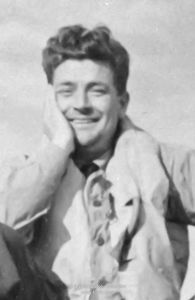
Sgt Rudolf Zima
Heinkel He 111H-2 Werke No. 3140 (coded A1+DA) of Stab Kampfgeschwader 53 was shot down by British fighters at 14:50 hours on Sunday 15th September 1940 whilst on a bombing raid to attack the Becton Gas Works, in East London. Shortly after releasing its twelve bombs, which dropped near the Becton Gas Works, it is believed to have been intercepted and shot down by Sgt Bohumír Fürst of 310 (Czechoslovak) Squadron but was also possibly attacked by F/O Blair D. Russell of No. 1 (RCAF) Squadron.
Heinkel He 111H-2, výrobní číslo 3140 (A1+DA), od 53. bombardovací eskadry byl sestřelen britskými stíhači v neděli 15. září 1940 ve 14:50 při útoku na Becton Gas Works ve východním Londýně. Krátce po shození svých dvanácti bomb, které dopadly poblíž cíle, byl pravděpodobně napaden a sestřelen Sgt. Bohumírem Furstem z 310. československé stíhací perutě. Dalším možným útočníkem byl F/O Blair D. Russel, příslušník 1. kanadské perutě.
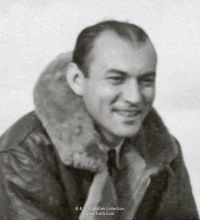
P/O Svatopluk Janouch
At 14:15 hours, that day, 12 Hurricanes of 310 (Czechoslovak) Sqn, led by F/Lt Jerrard Jefferies, had taken-off from Duxford for their second engagement of the day. They formed a Wing with 611, 19, 242 and 302 Sqns to intercept the enemy raid on London. On approaching London from the North, at 24,000 feet, the Wing sighted several formations of 20 to 30 Luftwaffe aircraft, consisting of Do 215’s, Do 217’s, He III’s and escorted by Me 109 and Me 110 fighter aircraft. It had been arranged that the Spitfires (19 and 611 Sqns) were to attack the fighters, the Hurricanes (242, 302 and 310 Sqns) taking on the bombers.
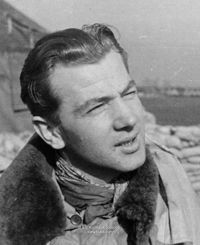
Sgt Josef Hubáček.
Toho dne ve 14:15 dvanáct Hurricanů 310. československé perutě vedených F/Lt. Jerrardem Jefferiesem odstartovalo z Duxfordu ke svému druhému operačnímu letu dne. Spolu s 611., 19., 242. a 302. perutí zformovaly wing a vydaly se ke střetnutí s nepřáteli nad Londýnem. Při přiblížení se k městu od severu ve výšce 24.000 stop zpozoroval wing několik formací tvořených dvaceti až třiceti stroji. Jednalo se o bombardéry Do-215, Do-217, He-111 v doprovodu stíhačů Me-109 a Me-110. Bylo rozhodnuto, že Spitfiry 19. a 611. perutě zaútočí na stíhací doprovod a Hurricany (242., 302. a 310. peruť) se zaměřily na bombardéry.
S/Ldr Hess, 310 Sqn leading ‘A’ Flight, consisting of ‘Red Section’ S/Ldr Alexander Hess. P/O Stanislav Fejfar, Sgt Bohumír Fürst, ‘Yellow Section’ P/O Svatopluk Janouch, Sgt Rudolf Zima and Sgt Eduard Prchal, followed 310 Sqn ‘B’ Flight, consisting of ‘Blue Section’ ‘F/Lt Gerard Jefferies, Sgt Josef Vopálecký, Sgt Josef Řechka, ‘Green Section’ Sgt Josef Hubáček, Sgt Raimund Půda and Sgt Jan Kaucký, in line astern in Sections. Luftwaffe fighters, escorting their bombers attacked ‘A’ Flight from the port and a general dogfight ensued.
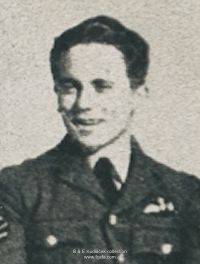
Sgt Josef Řechka
S/Ldr. Hess vedl letku „A“ složenou z „Červené sekce“ (S/Ldr.Alexander Hess, P/O Stanislav Fejfar a Sgt. Bohumír Furst) a “Žluté sekce“ (P/O Svatopluk Janouch, Sgt. Rudolf Zima a Sgt. Eduard Prchal). Před nimi do útoku jedna za druhou po sekcích letěla letka „B“ složená z „Modré sekce“ (F/Lt.Gerard Jefferies, Sgt. Josef Vopálecký, Sgt. Josef Řechka) a „Zelené sekce“ (Sgt. Josef Hubáček, Sgt. Raimund Půda a Sgt. Jan Kaucký). Stíhači německého doprovodu napadli letku „A“ z pravé strany a začalo střetnutí.
S/Ldr Hess’s aircraft was hit by cannon shells and he was forced to bail-out at only 500ft, landing uninjured at Billericay. Sgt Hrbáček, leading Green Section was also a casualty of that dogfight, being forced to bail-out for the same reason, landing at Chatham, with slight injuries.
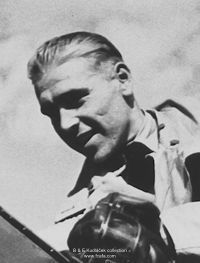
Sgt. Eduard Prchal
Stroj S/Ldr. Hesse byl zasažen palbou z kanónu a on byl nucen vyskočit na padáku v pouhých 500 stopách. Dopadl v Billericay nezraněn. Sgt. Hrbáček, vedoucí zelené sekce, byl sestřelen v tomtéž střetnutí. Ze stejného důvodu vyskočil na padáku a s lehkými zraněními dopadl v Chathamu.
Sgt Řechka, flying as Blue 3, chased a He III and attacked it with two other Hurricanes, he saw it crash on Foulness Island, which was witnessed by Sgt Prchal. P/O Fejfar, flying as Red 2 attacked and shot down a Do 17 which landed near Grain, 2 of the crew being taken prisoner. Sgt Vopálecký, Blue 2, saw a twin-engined aircraft marked with black crosses on upper wing surfaces and attacked it with two other Hurricanes but it escaped into the clouds. Yellow Section leader P/O Janouch sighted a seaplane when attacking another Luftwaffe fighter from above and rear which he believed to be a He 115.
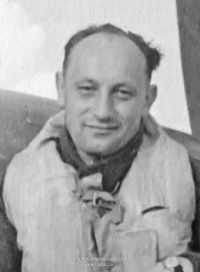
Sgt Jan Kaucký
Sgt. Řechka, který letěl jako „modrá 3“, pronásledoval He 111 a spolu s dalšími dvěma Hurricany na něj zaútočil. Viděl ho pak dopadnout na zem na Foulness Island. Svědkem mu byl Sgt. Prchal, F/O Fejfar. P/O Fejfar, který letěl jako „červená 2“ zaútočil na Do 17 a úspěšně ho sestřelil. Dornier přistál nedaleko Grainu a dva členové posádky byli vzati do zajetí. Sgt. Vopálecký, „modrá 2“, zpozoroval dvoumotorový stroj označený černým křížem na horní straně křídel a spolu se dvěma dalšími Hurricany na něj zaútočil. Bombardéru se ovšem podařilo ukrýt v mracích. Vedoucí žluté sekce P/O Janoch útočil shora zezadu na německý stíhací letoun a v tom spatřil hydroplán, o němž se domníval, že je Heinkel He-115.
Green 4, Sgt Kaucký, whose leader had been hit and bailed out, attacked with 2 Spitfires a Do 215 which went down in smoke uncontrolled to the ground.
Zelená 4, Sgt. Kaucký, lídr sekce byl sestřelen a vyskočil na padáku, zaútočil spolu se dvěma Spitfiry na Do-215. Tento stroj se v kouři nekontrolovaně zřítil k zemi.
Red 3, Sgt Fürst followed a formation of Do 215’s and He III’s he attacked a He III which was some distance from the formation. From his Combat Report about the attack:
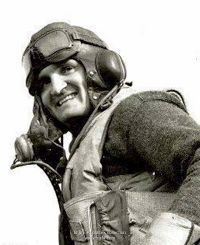
Sgt Bohumír Fürst
Červená 3, Sgt. Fürst pronásledoval formaci strojů Dornier Do-215 a He-111. Zaútočil na He-111, který byl částečně mimo formaci. V jeho bojovém hlášení čteme.
“We were attacked by Me 109’s West of London. Our section was broken up and when I could not find anyone of the section, I followed a formation of Do 215’s and He III’s. I attacked one He III which was a distance from the formation. The gunner of the aircraft fired at me. After I fired the first burst at him he stopped firing, probably hit. I made another attack from the rear at about 50 yards and saw splinters falling off the aircraft smoke streaming out of the starboard engine and the He III went out of control to the ground. Before it had disappeared, it was attacked by two Spitfires/ Oil and glycol spirited out of my engine and the temperature of the glycol was over 150 deg and the oil over 100 deg. I glided after the He III under the clouds and after a while I saw him crash in a part of London, near the Thames and a huge fire started immediately. I landed at Stapleford airfield and after having my engine repaired I returned to Duxford.”

Sgt Raimund Půda
„Západně od Londýna jsme byli napadení stroji Me-109. Naše sekce se rozpadla a nemohl jsem nikoho z ní najít. Pronásledoval jsem formaci strojů Do-215 a He-111. Napadl jsem jeden Heinkel He-111, který se nacházel mimo formaci. Jeho střelec na mě začal pálit. Poté, co jsem já vypálil první dávku, jeho střelba ustala, pravděpodobně byl zasažen. Provedl jsem další útok zezadu, přibližně z padesáti yardů, a viděl jsem, jak z letounu odpadávají úlomky a z levého motoru se valil dým. Stroj šel nekontrolovaně k zemi. Předtím, než mi zmizel z očí, byl napaden dvěma Spitfiry. Z mého motoru unikal glykol a olej a teplota glykolu byla přes 150 stupňů Farenheita, olej měl přes 100 stupňů Farenheita. Klouzavým letem jsem klesl pod mraky za Heinkelem a po chvilce ho viděl havarovat v Londýně, nedaleko Temže. Okamžitě se objevil obrovský plamen. Přistál jsem na RAF Stapleford a jakmile byl můj motor opraven, vrátil jsem se do Duxfordu.“
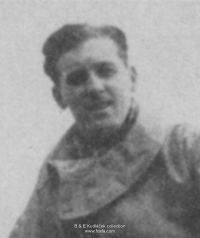
P/O Stanislav Fejfar
The pilot of the crippled Heinkel is believed to have attempted a forced-landing in an isolated area of Woolwich Arsenal, allocated for the hazardous task of shelling-filling, but one of its wings hit a coal dump causing it to crash into a water-filled moat and it exploded near Tripcock Pier. Of the crew; Feldwebel Arnold Benz, Feldwebel Alois Schweiger, Unteroffizier Heinrich Meyer and Unteroffizier Georg Geiger were killed, while Feldwebel Michael Cionber is believed to have baled out. He was captured badly wounded and was subsequently admitted to the Royal Herbert Hospital.
Pilot poškozeného Heinkelu se zřejmě pokusil o nouzové přistání v uzavřené oblasti továrny na výrobu střeliva v londýnském Woolwichi, ale jedno z jeho křídel zavadilo o hromadu uhlí a stroj následně havaroval do příkopu naplněného vodou. Nedaleko tripcockského mola pak explodoval. Členové posádky, Feldwebel Arnold Benz, Feldwebel Alois Schweiger, Unteroffizier Heinrich Meyer a Unteroffizier Georg Geiger, zemřeli. Feldwebel Michael Cionber pravděpodobně vyskočil na padáku, upadl do zajetí a s vážnými zraněními byl převezen do Royal Herbert Hospital.
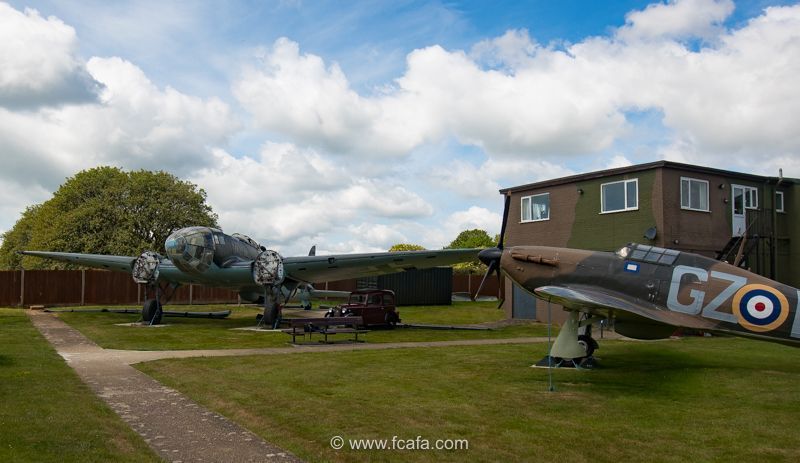
Some of the wreckage of this aircraft lay undisturbed until 1986 when the Arsenal was being developed to form part of the new Thamesmead Estate. Items including two MG 15 machine-guns, sections of armour plate, main undercarriage leg and tyre, large section of the gondola, coins etc where unearthed and are on show in the museum.
Část vraku tohoto stroje zůstala na místě až do roku 1986, kdy se v oblasti bývalé továrny začalo stavět a vyrostla zde část nového Thamesmead Estate.
Jeho části, včetně kulometů MG-15, částí ochranných kovových plátů, nohy hlavního podvozku, velká část gondoly, mince a další věci. Uskutečnily se zde vykopávky a v současnosti můžete tyto artefakty spatřit v muzeu.
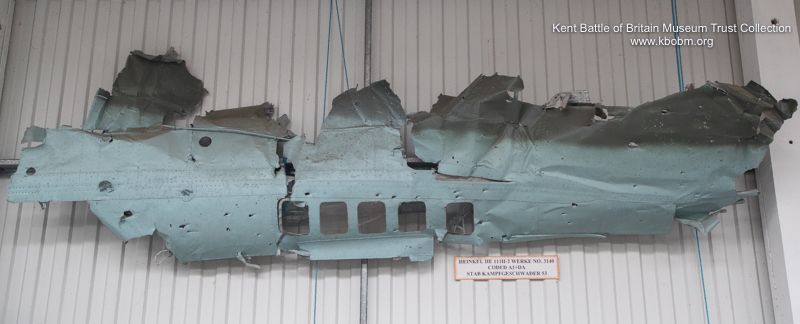
Gondala section.
Gondola
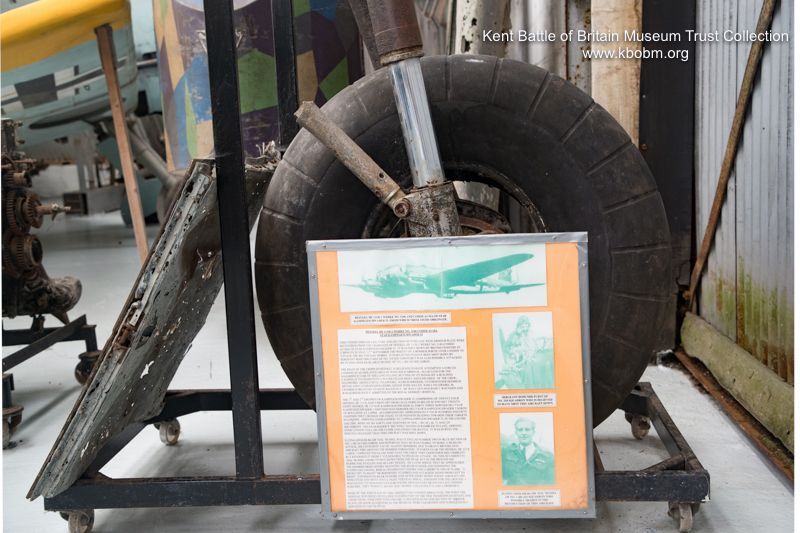
Undercarriage leg.
Noha podvozku
_______________________________________________________________
Heinkel He 111H-2 bomber A1+DA is the latest addition to the Museums expanding range of Battle of Britain items in its collection which have a Czechoslovak connection.
Bombardér Heinkel He-111H-2 A1-DA je nejnovějším přírůstkem v rozšiřující se sbírce předmětů z bitvy o Británii. Naleznete v ní i artefakty připomínající Čechoslováky.
Some 2938 Allied airmen flew in the Battle of Britain, of whom 88 were Czechoslovak some of whom have artefacts in the Museum. Of particular interest for visitors from the Czech and Slovak Republics is the display of some of the remains of Hurricane Mk I, V7437, in which Sgt Josef Koukal was badly burnt when he was shot down on 7 September 1940. His aircraft crashed on farmland at Capel Fleet, Harty Marshes on the Isle of Sheppey. Kent and was recovered, buried some 10 metres deep, in 1972. Later that year he came from Czechoslovakia to England to see the remains of his aircraft at the Museum. On his return to his homeland, he was subjected to StB interrogation which precluded any return visits to the UK.
Bitvy o Británii se zúčastnilo přibližně 2938 spojeneckých pilotů, mezi nimi i 88 Čechoslováků. Některé z československých pilotů připomínají i artefakty v majetku muzea. U návštěvníků z Česka a Slovenska se největšímu zájmu těší pozůstatky Hurricanu Mk I, V7437, ve kterém utrpěl 7. září 1940 těžké popáleniny Sgt. Josef Koukal. Jeho stroj, který havaroval na pole v Capel Street na Harty Marshes na Isle od Sheppey v Kentu, byl objeven v roce 1972 v hloubce přibližně deset metrů. Tentýž rok si přijel Sgt. Koukal z Československa prohlédnout trosky svého letadla v muzeu. Po návratu domů byl vyslýchán StB a následně mu byly znemožněny další návštěvy Velké Británie.
Other Czechoslovak artefacts include items from František Hradil’s Spitfire P7545, Josef František, a combat report from Bohumír Fürst, Raimund Půda also visited the Museum to see remains of his Hurricane V6619, František Marek’s Spitfire, Václav Bergman’s Hurricane P3960, Josef Hubáček’s Hurricane R4087, as well as from Vilém Göth, Josef Jaške and Svatopluk Janouch. Artefacts for George Blackwood, Gordon Sinclair and John Boulton, who were British instructors to 310 Sqn at Duxford, are also displayed in the Museum.
K dalším artefaktům československých letců zde patří části Spitfiru P7545, který pilotoval František Hradil, věci připomínající Josefa Františka, hlášení o boji Bohumíra Fürsta. Také Rajmund Půda navštívil muzem, aby viděl zbytky svého Hurricanu V6619, části Spitfiru Františka Mareka, Hurricanu P3960 patřícího Václavu Bergmanovi, Hurricanu R4087 Josefa Hubáčka a strojů Viléma Götha, Josefa Jaškeho a Svatopluka Janoucha. Jsou zde k vidění i artefakty George Blackwooda, Gordona Sinclaira a Johna Boultona, instruktorů 310. perutě v Duxfordu.
A new addition for the 2019 season is the inclusion of a Czechoslovak Sgt pilot in the Armoury display of uniforms.
Novým přírůstkem pro sezónu 2019 je figurína československého pilota v hodnosti seržanta umístěná ve zbrojnici, v oddělení uniforem.
_______________________________________________________________

